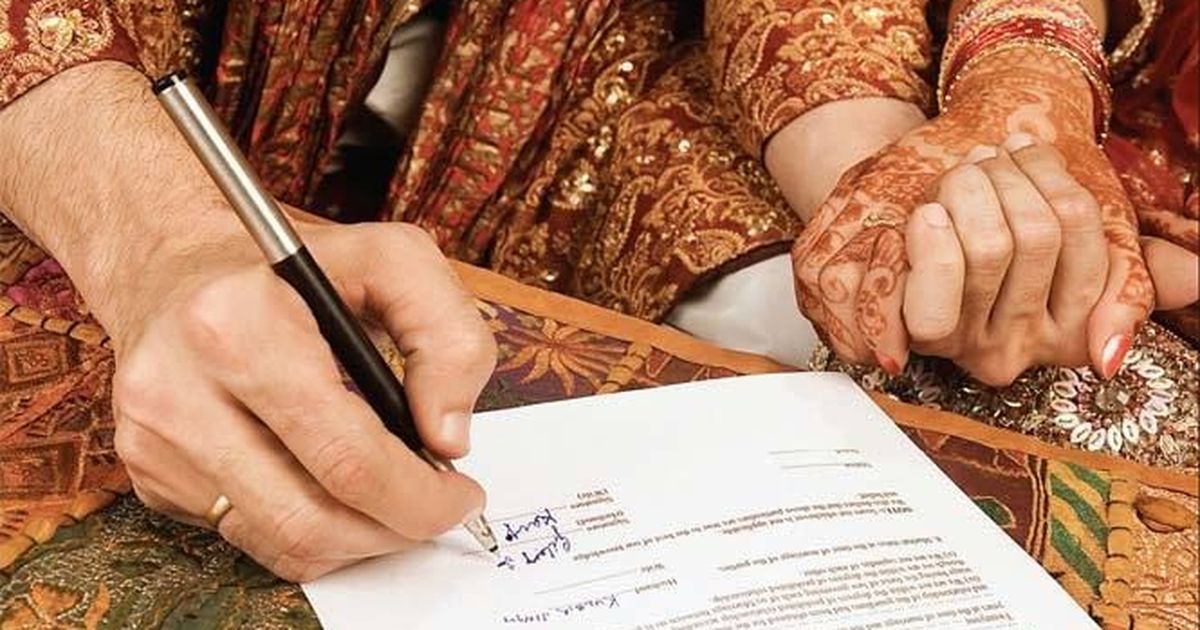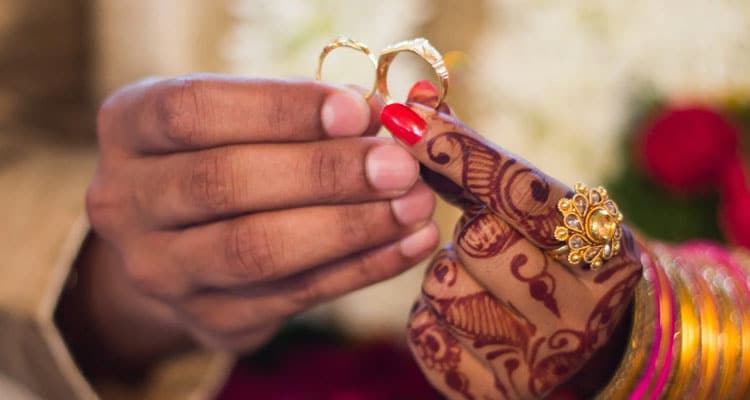Posted by Damini Mehta
Marriages are made in heaven, or that is what we are told at least. In India, marriage is a sacred institution across religions. The rituals and customs differ as we move from one place to another, but marriage as an institution remains central to the Indian social structure.
Keeping the centrality and its inevitability (at least for some) in mind, an interactive session was conducted to examine how marriage as an institution affects a woman’s role and identity in the family and household. We started off by raising a simple question, ‘What is your idea of marriage?’
We were unsure as to how the participants would define it, given none of them, including the three of us, were married. However, a look at their responses convinced us that our decision to dedicate a full session to it was completely justified. According to one of the participants, her idea of marriage stems from companionship or friendship between two people and the two people need not be a man and a woman.
Another participant on the other hand, attributed marriage directly to the idea of patriarchy. According to her, marriage is one of the centrifugal forces in reinforcing the idea of patriarchy across societies, to which most other participants agreed to an extent. Discussing amongst ourselves, we felt that there are so many strands of marriage that are discriminatory towards women that it was difficult to see it in all its glory. Most of us also felt that a marital institution leans power dynamics in favour of the male.
A historical study of marriage as an institution tells us that the idea developed as human beings started looking for greater stability in life. It eventually became problematic as a larger onus of maintaining this stability and sustaining this institution fell on the woman in the marriage. While they were expected to give up more, they were also held accountable, to a greater degree, for the failures or instabilities in the marriage

Looking at how one of the other participants perceives the institution of marriage, made us go back to the concept of socialisation we had discussed earlier. To her, marriage is defined by what she had seen in her parents’ relationship and other marriages around her. The subtleties of the power dynamics make her wonder if she would ever be ready for something like this. To her, marriage seems like a loaded dice, always falling for the man.
For another participant, marriage entails giving up on her own dreams and desires for that of the husband. The institution of marriage, according to her, is not mandatory when it comes to partnerships and feels like an institution forced by society, in ways that we do not even know. According to a different participant, marriage involves responsibility and care towards the family. She feels that the institution as we see it even today, has indeed imposed several constraints on the female, ranging from financial insecurity to dependence and control over the sexuality and physical autonomy of a woman.
Over the course of the discussion, while looking at different aspects of marriages, the conversation shifted between the need to create strong structures of companionship to rejecting tendencies that make marriages an impediment for women. The thought of two people living together and sharing a life were seen as the perks of marriages.
Also read: Kerala HC’s Marital Rape Judgment Finally Shifts The Focus Away From ‘Sanctity Of Marriage’
A historical study of marriage as an institution tells us that the idea developed as human beings started looking for greater stability in life. It eventually became problematic as a larger onus of maintaining this stability and sustaining this institution fell on the woman in the marriage. While they were expected to give up more, they were also held accountable, to a greater degree, for the failures or instabilities in the marriage.
Role allocation on societal lines has confined women and other gender minorities to roles within the household, while financial control and power lie with the men. Participants also felt that there is nothing wrong in women taking up roles inside the household and that society limiting their ability to take up roles only within the house is the root cause of the problem. Similarly, expecting that all men would be interested in taking up specific roles like providing financially for the family is equally limiting for them.
Marriages in our culture ring true with the concept of ‘matrimony’s essentialism’. It refers to a form of institutionalised inequality between genders that sees women as the property of their husbands – and before that, the property of their fathers. From kanyadaan to bidai, rituals and customs right from the beginning to the end of the life cycle of marriage, place women as the property of the male members. Before marriage, they are the responsibility of the father, after marriage of the husband, and if the husband dies earlier, of the son, thereby reducing her to an appendage to male dominance.
Participants also felt a general disregard towards the idea of arranged marriages. But to most of them, irrespective of the kind of marriage (arranged or love) the element of patriarchy and dominance is existent. The conversation seemed to reach an end point where most agreed that the elements of patriarchy and societal pressure do exist but with an equal companion, a marriage would make for something worth looking forward to. The participants also did not agree to the complete abolition of the idea of marriage, the focus, according to them, must be on making the power dynamics within a marriage more diffused
While going over the different aspects of difficulties one faces in marriage, most of the participants agreed with the conclusion that we should not completely abandon the concept. To them, just like we work on all other relationships, similarly, we should also work in a marriage if we choose to go ahead with it. Like every other relationship in our life requires commitment and efforts, marriage also involves a level of commitment from both the parties and instead of shedding the idea completely, we should talk to our family and our partners and discuss our inhibitions, if we would like to opt for marriage.
Participants also found symbolisms imposed on married women such as mangalsutra & sindoor disconcerting. Participants felt that, given how these symbols are applicable only to married women and not men, it is a clear example of the discriminatory nature of the institution. Many other symbolisms also perpetuate the hierarchy between the families of the bride and the groom.

Participants also felt that arranged marriages, a norm in India, involve an even greater deal of adjustment and compromise for the female. Moreover, another participant mentioned that the caste and class dynamics which are taken into consideration before marriages in India make it all the more complicated and a business like deal instead of an example of lifelong companionship.
Participants also felt a general disregard towards the idea of arranged marriages. But to most of them, irrespective of the kind of marriage (arranged or love) the element of patriarchy and dominance is existent. The conversation seemed to reach an end point where most agreed that the elements of patriarchy and societal pressure do exist but with an equal companion, a marriage would make for something worth looking forward to. The participants also did not agree to the complete abolition of the idea of marriage, the focus, according to them, must be on making the power dynamics within a marriage more diffused.
They also realise that the idea of marriage is changing as we see it now and couples no longer choose to remain in the constraints of the institution. Communication between the partners has improved, queer partnerships have become more visible, and it has positively affected the problematic structure of the institution itself.
Also read: Raising Marriageable Age Of Girls: A Step That Requires Comprehensive Execution
Editor’s Note: This is the fourth article in a series based on a Social Action Project called ‘Consciousness Raising Sessions on ‘The Role of a Female in the Indian Household’. This was formulated by fellows with Participatory Research in Asia (PRIA)’s Youth-N-Democracy program. The Social Action Project aimed to connect with women in the age group of 19-26 years of age in order to introduce them to the idea of how unseemingly common everyday activities turn out to be deeply discriminatory
Damini has a Masters in Arts in Public Administration and is currently working as a Research Associate with a consultancy firm. She has a keen interest in politics and public policy research and has been pursuing various engagements in the same including presenting research findings at international conferences. She has a knack for reading and writing and loves to engage in discussions that challenge the intellect. She may be found on Facebook, Instagram, LinkedIn, Twitter and Medium
Featured Image Source: Bonobology.com
About the author(s)
We are a global centre for participatory research and training. For 39 years, PRIA has focused on empowerment of the excluded through capacity building, knowledge building, and policy advocacy. We work to make democracy work for all.






Marriage is a punishment today, with draconian laws, fake dowry cases, false cases of domestic violence, men lose their life savings in alimony and child support payments, don’t get to see their children, lose their job and reputation after false cases, suffer from acute depression …